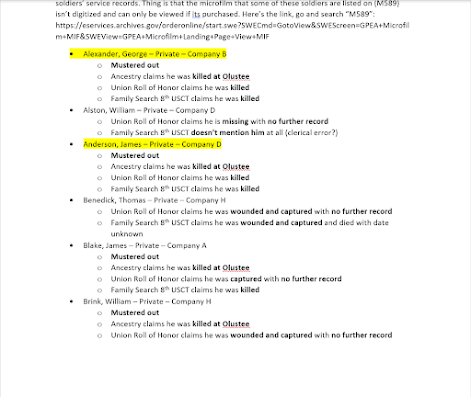Week 5 | Deadlines
Hello all, Aaron here for another update on the Olustee project. This week has actually been relatively tame in terms of how much work I’ve needed to do for both the internship and my other classes. I better enjoy it while it lasts however; the next two weeks are going to be brutal. I have an essay due next week for one class, and a second essay due the next week for another; this corresponds to a timeframe Dr. Gannon outlined in our meeting today that we have to achieve some pretty big milestones in the Olustee project, so I’m a little wary of how these next weeks will progress. First I’ll go over what Dr. Gannon has revealed will be going down in the coming weeks, and then I’ll mention what I’ve accomplished in my research over the past week.
So, in our meeting today (first communicated in an email on Tuesday), Dr. Gannon updated us on the matter she discussed with the journalist I mentioned in last week’s blog post. The journalist is aiming to have an article about the Olustee battlefield and lack of a Union memorial by next weekend: February 19th or 20th, with the digital article being available sooner. As such, Dr. Gannon told us to “be ready for emails that say “can you do this” or “that”. Said journalist is especially interested in the names of the dead, so likely by early next week I’ll need to have at least a rudimentary list of the 8th and 35th USCT dead. The following weekend, the Florida Conference of Historians is being held near Tampa (on the 25th through the 27th), and Dr. Gannon is aiming to have an Olustee “story map” completed by that date so it can be presented at the convention. A “story map” just refers to a webpage that aims to be a comprehensive account of something; the Olustee story map was created before my time in the internship and was shown to me when I first started work. On the story map is the history of the Battle of Olustee, an overview of what happened afterwards, and the condition of the gravesite and national park. Most of what I mentioned in my Week 1 and 2 blog posts came from the story map that was worked on by previous interns in the project. Since Dr. Gannon is going to be using the story map in the presentation at the conference, she wants us to fact check it once it's complete. I am unsure how difficult it will be to validate these facts on a timed schedule such as this but I’m sure the other interns and I will be able to get it done.
As for what I have personally been researching this last week, I’ve focused more on what sources are currently available to me rather than looking for new ones. To organize the information from the mustered out spreadsheet and the casualties worksheet more concisely, I made a Word document (pictured above) that lists all of the names of soldiers in which at least one source has named them as having died at Olustee. This is just the first page, but in its current form, I’ve written down all the names from the 8th USCT and have at least one source that mentions them written underneath. So far, the amount of sources any one soldier has is three: the “mustered out” spreadsheet (whose source is Ancestry.com), the “casualties” spreadsheet (whose source is the “Union Roll of Honor” which mentions the order of battle for Olustee), and Familysearch.com, which compiles service records for soldiers. Familysearch.com has a page dedicated to the 8th USCT, and that page hosts records of Pennsylvanians that served in the Union Army. Generally, there is agreement between the three sources—I’ve highlighted the names of soldiers where all three sources agree that they were killed at Olustee. In other cases, the sources agree, but cannot confirm a death, like in the case of Thomas Benedick. Furthermore, some soldiers have two sources that agree but one that does not, like in the case of James Blake and William Brink (Brink’s Familysearch.com source is cut off at the bottom of the page). And in very rare cases, some sources do not mention a soldier that another does, like in the case of William Alston. I’ve noted down all of these discrepancies, and the idea is that when I finish this document for the 35th USCT as well, I’ll have a list of soldiers that are the most likely candidates for burial in the Olustee mass grave—and these are the soldiers that have all of their sources assert the same conclusion.

Comments
Post a Comment